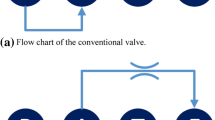Abstract
Control valves are very important actuators in the process industry. Due to friction in the stem, they present a nonlinear behavior, which can generate errors in the stem position and oscillations in control loops. This paper presents five control algorithms based on feedback linearization technique, to deal with pneumatic control valves affected by high friction in their stems. These control algorithms measure the valve position and manipulate the actuator pressure, acting as a valve positioner. The paper also shows practical results with a control valve operating in a real flow control loop.


































Similar content being viewed by others
References
Arifin, B. M. S., Munaro, C. J., Choudhury, M. A. A. S., & Shah S. L. (2014). A model free approach for online stiction compensation. In Proceedings of the 19th IFAC World Congress, August 24–29, Cape Town, South Africa, pp. 5957–5962.
Bacci, R. C., Scali, C., & Pannocchia, G. (2016). System identification applied to stiction quantification in industrial control loops: A comparative study. Journal of Process Control, 46, 11–23.
Canudas de Wit, C., Olsson, H., Åström, K. J., & Lischinsky, P. (1995). A new model for control of systems with friction. IEEE Transactions on Automatic Control, 40(3), 419–425.
Choudhury, M. A. A. S., Shah, S. L., Thornhill, N. F., & Shook, D. S. (2006). Automatic detection and quantification of stiction in control valves. Control Engineering Practice, 14(12), 1395–1412.
Choudhury, M. A. A. S., Thornhill, N. F., & Shah, S. L. (2004). A data-driven model for valve stiction. In Proceedings of the 5th IFAC Symposium on Advanced Control of Chemical Process (ADCHEM), Hong-Kong.
Cuadros, M. A. D. S., Munaro, C. J., & Munareto, S. (2012). Improved stiction compensation in pneumatic control valves. Computers & Chemical Engineering, 38, 106–114.
Dahlin, E. B. (1968). Designing and tuning digital controllers. Instruments & Control Systems, 41(6), 77–83.
Ender, D. (1997). Implementation of deadband reset scheduling for the elimination of stick-slip cycling in control valves. In Process Control Electrical & Information Conference.
Garcia, C. (2008). Comparison of friction models applied to a control valve. Control Engineering Practice, 16(10), 1231–1243.
Hägglund, T. (2002). A friction compensator for pneumatic control valves. Journal of Process Control, 12, 897–904.
Hägglund, T. (2007). Automatic on-line estimation of backlash in control loops. Journal of Process Control, 17, 489–499.
Henson, M. A., & Seborg, D. E. (1991). An internal model control strategy for nonlinear systems. American Institute of Chemical Engineers Journal, 37(7), 1065–1081.
Henson, M. A., & Seborg, D. E. (1997). Nonlinear process control. Upper Saddle River: Prentice Hall.
Isidori, A. (1989). Nonlinear control systems: An introduction. Berlin: Springer.
Kano, M., Hiroshi, M., Kugemoto, H., & Shimizu, K. (2004). Practical model and detection algorithm for valve stiction. In Proceedings of the 7th IFAC symposium on dynamics and control of process systems (DYCOPS), Cambridge, MA, USA.
Karnopp, D. (1985). Computer simulation of stick-slip friction in mechanical dynamic systems. Journal of Dynamic Systems, Measurement and Control, 107(1), 100–103.
Kayihan, A., & Doyle, F. J. (2000). Friction compensation for a process control valve. Control Engineering Practice, 8(7), 799–812.
Li, C., Choudhury, M. A. A. S., Huang, B., & Qian, F. (2014). Frequency analysis and compensation of valve stiction in cascade control loops. Journal of Process Control, 24, 1747–1760.
Mishra, P., Kumar, V., & Rana, K. P. S. (2014). A novel intelligent controller for combating stiction in pneumatic control valves. Control Engineering Practice, 33, 94–104.
Mishra, P., Kumar, V., & Rana, K. P. S. (2015). An online tuned novel nonlinear PI controller for stiction compensation in pneumatic control valves. ISA Transactions, 58, 434–445.
Mohammad, A., & Huang, B. (2012). Compensation of control valve stiction through controller tuning. Journal of Process Control, 22, 1800–1819.
Romano, R. A., & Garcia, C. (2008). Karnopp friction model identification for a real control valve. In Proceedings of the 17th World Congress of IFAC, pp. 14906–14911.
Slotine, J. J., & Li, W. (1991). Applied nonlinear control. Upper Saddle River, NJ: Pretince Hall.
Sobczyk, M. R., Gervini, V. I., Perondi, E. A., & Cunha, M. A. B. (2016). A continuous version of the LuGre friction model applied to the adaptive control of a pneumatic servo system. Journal of the Franklin Institute, 353, 3021–3039.
Srinivasan, R., & Rengaswamy, R. (2005). Stiction compensation in process control loops: A framework for integrating stiction measure and compensation. Industrial & Engineering Chemistry Research, 24(44), 9164–9174.
Srinivasan, R., & Rengaswamy, R. (2008). Approaches for efficient stiction compensation in process control valves. Computers & Chemical Engineering, 32(1–2), 218–229.
Wang, T., Xie, L., Tan, F., Su, H. (2015). A new implementation of open-loop two-move compensation method for oscillations caused by control valve stiction. In Proceedings of the 9th International Symposium on Advanced Control of Chemical Processes—ADCHEM, Whistler, British Columbia, Canada, pp. 433–438.
Author information
Authors and Affiliations
Corresponding author
Rights and permissions
About this article
Cite this article
Baeza, J.R., Garcia, C. Friction Compensation in Pneumatic Control Valves Through Feedback Linearization. J Control Autom Electr Syst 29, 303–317 (2018). https://doi.org/10.1007/s40313-018-0382-y
Received:
Revised:
Accepted:
Published:
Issue Date:
DOI: https://doi.org/10.1007/s40313-018-0382-y



